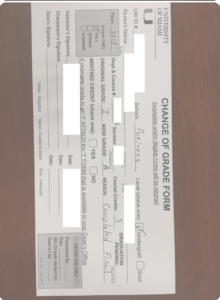A good friend of mine is an adjunct faculty member at a prestigious private university in the south. The university where he teaches has both top-rated academics and top-rated athletics. Four-year student tuition exceeds $300,000.
My friend is an accomplished expert in his subject — entrepreneurship. He gets rave reviews from his students. Nonetheless, he decided not to teach this coming year. His reason? The school’s internal administrative inefficiencies frustrated him often. There was a real lack of digital business processes in place, and he didn’t have time to deal with it any longer.
A Dysfunctional Grade Change Request Process
My friend complains about most of the administrative processes at the university. There was one in particular that pushed him over the edge — the university’s Grade Change Request Process. Last semester he had two students that could not take the final exam. Each student received a grade of Incomplete until they could take a make-up exam. After each student took the make-up exam, my friend had to follow the university’s grade change request process. The changes happened in the university’s Student Information System (SIS).
My friend was on the part-time faculty at the time. He emailed the department’s administrative assistant about how he could make the change. What he heard astonished him. She asked if he could come to the management department on campus to sign the form in-person. The office was 10 miles from my friend’s house.
That’s right. This is a paper-based process at a university where a four-year degree costs more than $300,000! It is a university that is preparing students to enter a modern workforce. And yet grade change processes use carbonless paper, along with many other processes.
To start a grade change request, the faculty member completes a grade change request form. Back then, this was a tricolor carbonless copy paper form.

Someone must sign the form in-person, handing it to the department’s administrative assistant. That assistant then places the form in the Department Chairperson’s office inbox. Once reviewed and signed, the form goes back to the administrative assistant. That assistant then walks the form to the Registrar. This is where the grade updated in the university’s Student Information System (SIS).
Of course, this is a sensitive process. An audit trail with signatures is necessary to protect against error or fraud.
A Process Inefficiency Nightmare
Two weeks afterward, my friend received complaints from the students with grade changes. They asked why their grade remained the same. One of the students was quite upset because the grade change was essential for her to be able to enroll in the next semester’s desired classes.
After asking the administrative office, my friend learned that both of his submitted forms were “misplaced” along the way. Yes, that is correct… misplaced. Both of them. The academic secretary admitted that this happens quite often.

Over time, the administrative assistant was able to locate both forms after an extensive search. They were at the bottom of the department chairperson’s inbox. The administrative assistant apologized in the name of the university for the inconvenience. Luckily, my friend did not have to return to campus and repeat the process.
How did we get here?
Even if we ignore the 100% failure rate of this process in this particular instance, it is obvious that the process is quite broken. This is a sensitive and important process in the typical student journey. It is a process which can cause a great deal of anguish and stress for most students.
It appears that this process is not measured at all. In a high functioning organization, team members should know how long a process like this takes in the best, worst, and median cases. In a high performing organization, there would be performance goals and KPIs that go into a single performance score. Even the university president is at fault here. A digitally-savvy university president should demand these sorts of KPIs. Nothing less than a digital dashboard reflecting a score on how the university is doing. This “student journey score” sends officials digital alerts the moment that score has dropped below an acceptable level.
Instead, this $300,000 per year university is still using tricolor carbonless copy paper forms to manage critical processes in the student journey.
Raising Your Organizational Process IQ
At ProcessMaker I work with academic institutions, banks, and businesses around the globe to improve and automate processes. The first questions my team and I ask any client are the following:
- Who owns this process?
- What are the target outcome and target duration for the end-to-end process?
- Can the process be simpler?
- What strategic goals of the institution does it affect if these goals’ Key Performance Indicators (KPIs) are not met?
- What do success and failure look like?
If these questions existed at this particular university, then this level of process failure would not be possible. Let’s look at each question:
Process Owner
Every process identified in an organization has to have a single owner. The owner owns the end to end process and has to make sure all the questions above get answered and revisited.
Target Outcome and Duration
The process owner should sit with key stakeholders and determine the expectations for the process. How long do users expect the process to take? What information do they expect to provide during the process? Based on process expectations, we can determine what is sometimes called an Apdex score or application performance score. To put it another way, this is the process “happiness indicator.” It reports how many users are happy, tolerating, or frustrated with their process experience. In the case of the Grade Request Process that my friend and his students experienced at his university, they both ended the process in a state of “extremely frustrated.” Why? What was their expectation of how long the process should take? Would 5 days have been acceptable? Or should the target be 48 hours?
Simplifying the Process
By diagramming the process, we should be able to see both our desired outcome (the happy path) and also discover the not so obvious “non-happy path” outcomes. For a student grade change request, the desired outcome is the completed grade change. Under what circumstances might the result not be a grade change.
Under what circumstances and how often do the chairperson and academic dean reject the request? And what would happen then?
Of course, here we may learn other things about our process. We may learn that the chairperson only rejects. 1% of requests and the Dean has never rejected a request. Well, in this case — why not cut these steps and simplify the process. Or we could use AI (artificial intelligence) to only require this step if certain conditions are met (for example, if the student has requested more than 3-grade changes in a year).
KPIs and Strategic Institutional Goals
Academic institutions around the world are suffering from both budget and student retention pressures. Most institutions have as a primary strategic goal increase retention and lower operating costs. How does the Student Grade Change Process map to these strategic goals? In this instance, the process caused enormous frustration for both the student and the professor. This is a clear area where the student journey could improve.
Failure and Success
In this case, we had a clear process of failure. The failure resulted in a dissatisfied student and teacher experience. The experience contributed to emotional anguish for the student and contributed to a brilliant professor deciding not to continue teaching the following semester.
What is surprising about this whole story is that this major university is not the exception — it is the norm across the US. Universities everywhere are using outdated systems, or even as in this case, paper-based systems. In the modern industry, a company would get eaten alive by its competition if it did not have an established goal or service level for a key process.
How come the university did not have a monitoring system in place to report on all Grade Change Requests that take longer than X days to complete?
Does the university have a Service Level Agreement (SLA) that it holds itself to for this key process?
If I were the Dean of Student Life at this school, you can be sure that I would run a student survey, figure out how long it is acceptable in today’s digital world for this process, and then I’d want to know every time I missed my target. And every time I miss my target, I would know that I was another contributing factor to the “inconvenience” of completing a college education that results in high dropout rates.
Why Reporting is DEAD
I’d go one step further. If I am looking at an SLA report that shows weekly failures in a process, it is already too late. I already have delivered a “frustrating customer experience” — in this case to the student and the professor. The age of reporting is dead. If it’s on a report, it has already happened and it is too late. If my process is digital, and I have set up my process correctly, I should be able to get real-time alerts the moment a non-conforming process starts to happen. In this grade change example, 3 signatures are required to process the grade change.
So, perhaps through careful student focus groups, we decided that the entire process should never take more than 48 hours, and no individual signer should take more than 6 hours. This process could have alerts set on each of these tasks so that stakeholders know the moment of an SLA violation. The moment the Chairperson’s task is 6 hours and 1 minute old, an SMS could be sent to the professor and the Dean alerting them that this process is now at risk of not meeting its internal performance goal. We could even get more transparent if we want and notify the student every step along the way and when any delays happen.
What do you think would happen if this university implemented this type of digital process across the board for all processes that touched students or faculty? What if they had this type of Business Activity Monitoring (BAM) running university-wide.
I can tell you what would happen. Word would spread and it would spread quickly. Students and faculty would start to rave about their institution. They would be proud of the efficiency and transparency, and they would know that their institution is doing everything it can to help students focus on what matters most — learning.
About ProcessMaker
ProcessMaker is a low-code business process management and workflow software. ProcessMaker makes it easy for business analysts to collaborate with IT to automate complex business processes connecting people and existing company systems. Headquartered in Durham, North Carolina in the United States, ProcessMaker has a partner network spread across 35 countries on five continents. Hundreds of commercial customers, including many Fortune 100 companies, rely on ProcessMaker to digitally transform their core business processes enabling faster decision making, improved compliance, and better performance.





